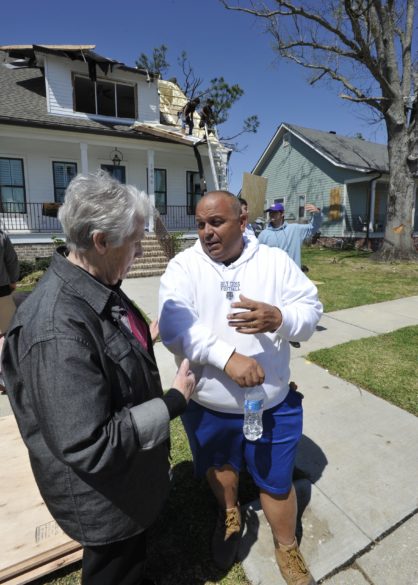

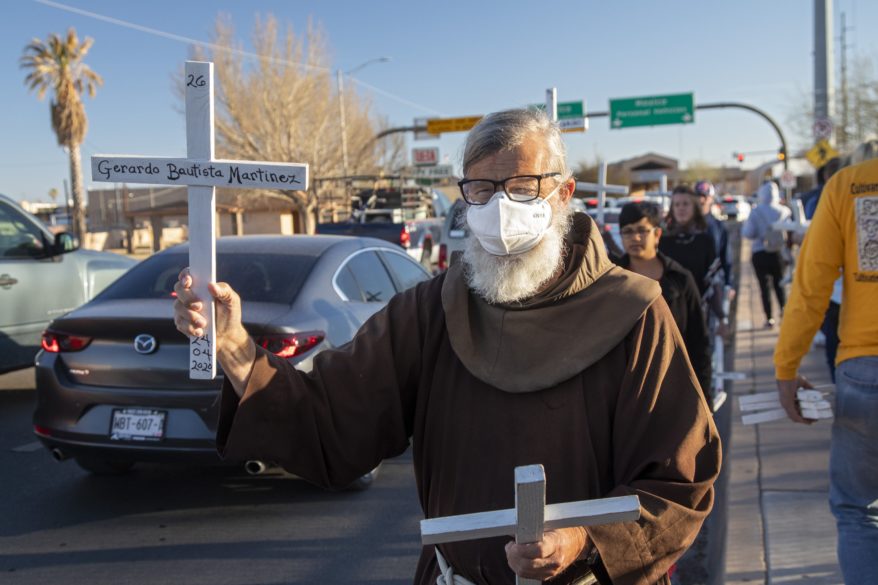
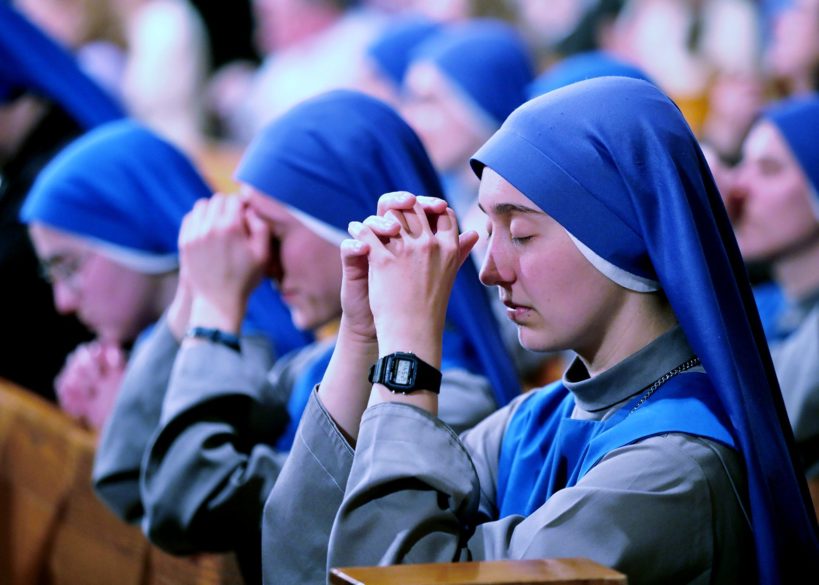
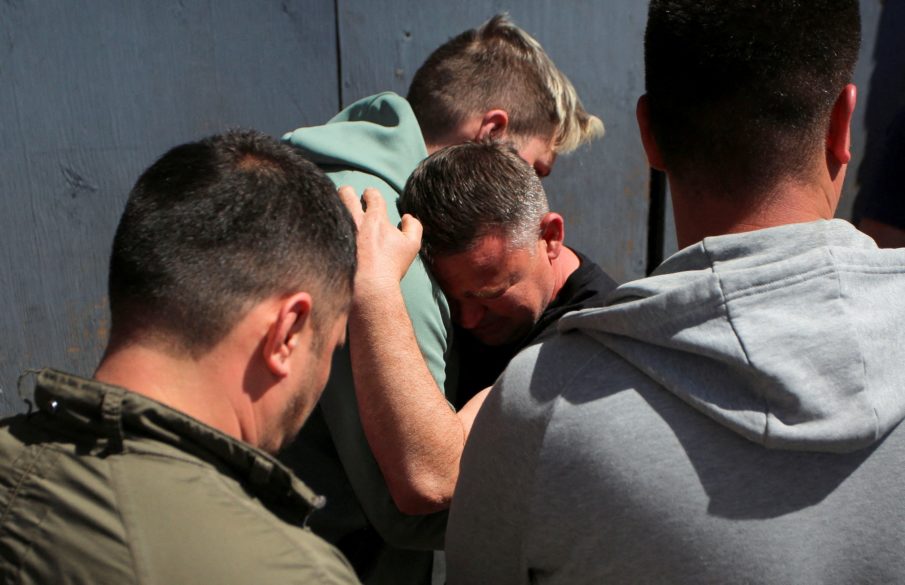





JACKSON – On Feb. 28, Bishops Joseph R. Kopacz and Louis F. Kihneman, III of the Dioceses of Jackson and Biloxi wrote a letter to Speaker of the House, Phillip Gunn, expressing their concern over Senate Bill 2643, specifically its proposal for a 13th cause that in effect would open the door to a process of unilateral divorce.
The Bishops wrote that “For the past 50 years the State of Mississippi rightly has codified the compelling grounds that protect the rights of the injured party in a marriage to petition for divorce. Desertion, chronic drug and/or alcohol abuse, spousal domestic abuse, intellectual disability and mental illness do erode and can devastate the bond of marriage. The rights and wellbeing of the injured spouse and family members must be upheld in such cases.”
With regard to mental illness the Bishops expressed this 12th cause for divorce thoroughly addresses the safeguards that must be in place in order to determine beyond a reasonable doubt that the mental illness undermines one’s capacity for marriage. These precautions are prudent and just and well-grounded in jurisprudence that surrounds marriage with the presumption of permanence.
“As written, [the 13th cause] is lacking in any of the intrinsic safeguards that are so evident in the 12th cause on mental illness,” wrote the Bishops. “… the 13th cause appears to be going down a slippery slope that could erode the institution of marriage and thus undermine the common good of society.”
On March 1, SB2643 died in committee in the House after passing through the Senate. However, the proposed amendment adding the thirteenth cause for divorce, was added to House Bill 770, an act to create the Mississippi Equal Pay Act, by the Senate on March 1, keeping the amendment alive.
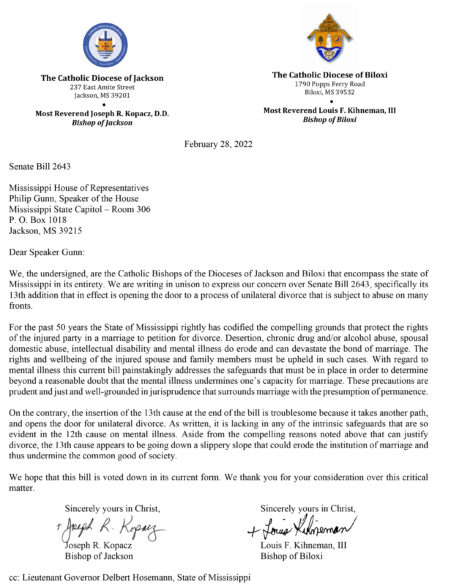
NATION
TALLAHASSEE, Fla. (CNS) – The Catholic bishops of Florida praised the state Legislature for passing a measure to prohibit most abortions after 15 weeks of pregnancy. H.B. 5 also includes provisions to improve infant health and analyze and reduce fetal and infant mortality. “While we continue to look forward to the day when the full protection of unborn life is recognized in law, we are encouraged that H.B. 5 further limits the grave harm that abortion inflicts upon women and children,” said Christie Arnold, associate for social concerns and respect life at the Florida Conference of Catholic Bishops. The conference said in a March 3 news release that Republican Gov. Ron DeSantis has expressed support for this legislation and is expected to sign it into law. “In an incremental, yet important, step, the bill provides at least eight additional weeks of protection for children in the womb. Current Florida law prohibits abortion when a child is viable, or able to survive outside the womb – currently closer to 24 weeks,” the release said. H.B. 5 “closely tracks” the Mississippi law at issue in the Dobbs v. Jackson Women’s Health Organization case pending at the U.S. Supreme Court, which could reverse “the unjust ruling” in Roe v. Wade, the conference noted. “If the Supreme Court upholds Mississippi’s law, Florida’s legislation will likely be upheld.”
WASHINGTON (CNS) – In the fall of 1979, Manuel Williams drove to a neighboring Alabama parish to hear a talk by Sister Thea Bowman, a dynamic Catholic speaker and evangelist known for her joyful singing and storytelling. She also challenged the church to welcome the gifts of Black Catholics and celebrate their African heritage that had shaped their culture and faith. Remembering the first time he saw the tall Black woman religious wearing an African dress, he said, “She strode on the stage as well as any Broadway actress or denizen of the performing arts would do. On top of her head she had these meticulous braids you could almost describe as a crown. She was captivating.” Sister Thea, he remembered, had a style all her own. “She smiled. She taught. She told stories. She chastised. She affirmed. She cajoled, and she punctuated it all with a searing and a soaring (singing) voice.” Afterward, Sister Thea met him and encouraged him to become a priest. Father Williams, a priest of the Congregation of the Resurrection, Williams reflected on her life and legacy and her message for today in a Feb. 15 talk at The Catholic University of America titled, “The Wisdom of Sister Thea Bowman for a Church in Crisis.” Sister Thea, who died in 1990, was a Franciscan Sister of Perpetual Adoration and is a candidate for sainthood.
WASHINGTON (CNS) – Although next year’s world Synod of Bishops on synodality may seem like it would be something far removed from U.S. Catholic college students, many are hoping that’s not the case. “Synodality is the chance to be creative in imagining the future of the church. Use this chance. … Catholic colleges and universities can make a contribution,” a theologian told a group of Catholic college leaders in February. Massimo Faggioli, professor of historical theology at Villanova University, outside of Philadelphia, urged Catholic leaders during the annual gathering of the Association of Catholic Colleges and Universities in Washington, to be invested in the synod not only because Catholic colleges are a big part of the church but also because there is currently a “crisis of trust in institutions” and Catholic colleges are not immune to it. Vincentian Father Guillermo Campuzano, vice president for mission and ministry at DePaul University in Chicago, agreed, saying the challenge in this whole process will be to “capture the singular voice of the church,” which will need significant input in order to be an accurate portrayal. He emphasized that above all, the synod should “fully embrace the meaning of diversity in the Catholic Church.”
VATICAN
VATICAN CITY (CNS) – Coexistence between older and younger generations can bring about a better appreciation for life that is often lost in today’s fast-paced society, Pope Francis said. A pervasive “spirit of rejection” exists in the modern world that “tends to be hostile to the elderly and, not by chance, also to children” and “casts them aside,” the pope said March 2 during his weekly general audience. “The excess of speed puts us in a centrifuge that sweeps us away like confetti,” he said. “One completely loses sight of the bigger picture,” and instead is tossed about by an attitude dictated by market forces “for which slower pace means losses and speed is money.” The pope continued his new series of talks dedicated to the meaning and value of old age and reflected on the theme, “Longevity: symbol and opportunity.” The long life of the patriarchs recorded in the Bible, he said, “confers a strong, a very strong symbolic meaning to the relationship between longevity and genealogy.”
VATICAN CITY (CNS) – As the Russian military continues to bombard Ukraine, the Vatican is mobilizing efforts to provide humanitarian assistance to those suffering. After Pope Francis’ announcement that he was sending two cardinals to Ukraine, the Vatican said March 7 that Polish Cardinal Konrad Krajewski, papal almoner, and Canadian Cardinal Michael Czerny, interim president of the Dicastery for Promoting Integral Human Development, intend to reach Ukraine “in the coming days,” depending on the situation. “Cardinal Krajewski is on his way now, March 7, toward the Polish-Ukraine border where he will visit refugees and volunteers in shelters and homes,” the Vatican said. Cardinal Czerny was to arrive in Hungary March 8 “to visit some reception centers for the migrants coming from Ukraine,” the Vatican said. “The cardinals will bring aid to the needy and serve as the presence not only of the pope, but of all the Christian people who express solidarity with the people of Ukraine,” the statement said. According to the Vatican, Cardinal Czerny also intends to raise concerns regarding the treatment of African and Asian residents in Ukraine. Many have reported acts of discrimination against them as they attempt to flee the country. “There are also worrisome reports of increasing activities of human trafficking and smuggling of migrants at the borders and in the neighboring countries,” the statement said.
WORLD
ROME (CNS) – The attack on and seizure of Ukraine’s Zaporizhzhia nuclear power plant by Russian forces could lead to an ecological disaster 10 times worse than the Chernobyl nuclear disaster, said the head of the Ukrainian Catholic Church. In a video message released March 4, Archbishop Sviatoslav Shevchuk of Kyiv-Halych said the attack should be a cause of concern for the world, especially for those “who care for the environment, those who care for the ecological awareness of humanity. This is not only becoming a humanitarian catastrophe before our very eyes. It is an irreversible attack on God’s creation that for decades, for centuries, will be impossible to correct,” he said. “Ukraine already experienced Chernobyl. Now it stands on the threshold of a new atomic threat that can be 10 times worse.” According to the Reuters news agency, a fire that broke out at a training center in the facility, which is the largest nuclear power plant in Europe, was extinguished after Russian troops captured the site. Although the fire took place in an area outside the main plant and there were no signs of elevated radiation levels, the attack prompted a response from the International Atomic Energy Agency. “I’m extremely concerned about the situation at the Zaporizhzhia nuclear power plant and what happened there during the night,” said Rafael Grossi, head of the IAEA, in a March 4 statement.
MEXICO CITY (CNS) – Mexican church leaders condemned a horrific brawl between fans at a professional soccer match, images of which horrified the country and raised uncomfortable questions about rising violence further permeating Mexican life. The brawl erupted at a match March 5 in the central city of Querétaro between supporters from home squad Querétaro and fans from rival team Atlas. Querétaro Gov. Mauricio Kuri said the melee left 26 fans injured – with no deaths, contrary to early media reports – though supporters of Guadalajara-based Atlas flooded social media with pleas for help finding missing fans. The Mexican bishops conference said in a statement immediately after the incident that it “categorically reproaches any episode of violence, however minimal. We exhort sporting clubs, the authorities and civil society to make football and any sport an opportunity to create spaces of integration and not of confrontation (for) reconstructing the social fabric, so damaged and in need of dialogue, respect, comprehension and tolerance,” the bishops said. Gruesome images streamed from Corregidora Stadium showed fans being kicked unconscious, battered bodies strewn naked on the stadium concourses and frightened families rushing the field for safety. The fighting spilled onto the field and some combatants could be seen with weapons.
YAOUNDÉ, Cameroon (CNS) – A bishop in Cameroon’s troubled South West region said he is saddened by the rising number of kidnappings in the country’s two violence-ravaged English-speaking areas. Bishop Michael Bibi of Buéa expressed shock over the Feb. 24 kidnapping of 11 teachers of a government-run school for blind and deaf students in the country’s North West region. “It is sad, very sad that teachers should be kidnapped simply because they are teaching,” Bishop Bibi told Catholic News Service. “The question I am asking myself is why do you kidnap and torture and even kill the very people you say you are fighting to free?” Cameroon’s English-speaking North West and South West regions have been embroiled in war for the past five years, with separatists fighting to create a new nation to be called Ambazonia. Since the conflict began, at least 4,000 people have been killed and more than 1 million forced to flee from their homes.
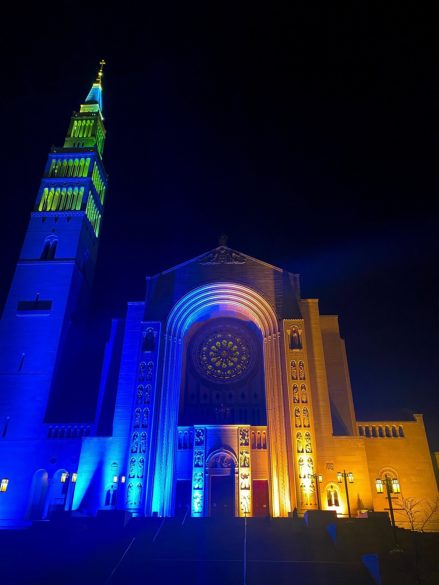
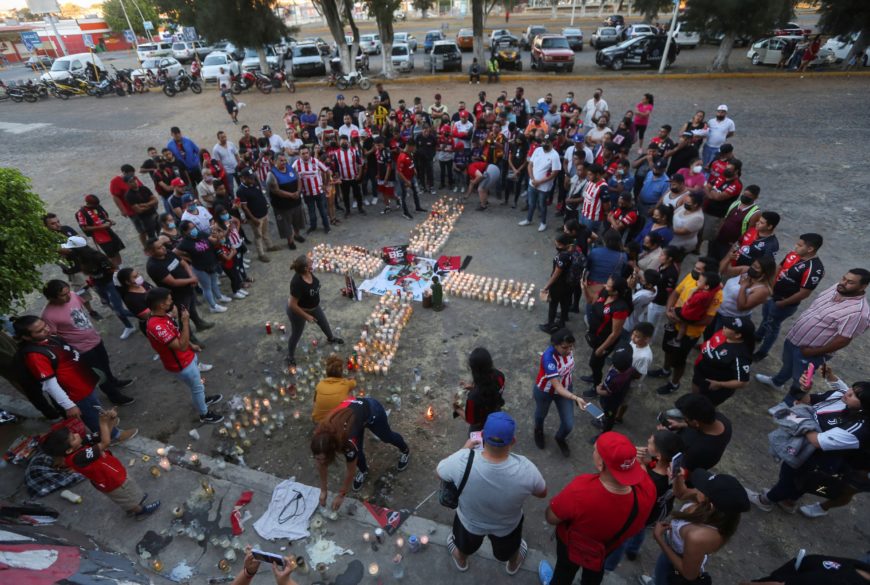
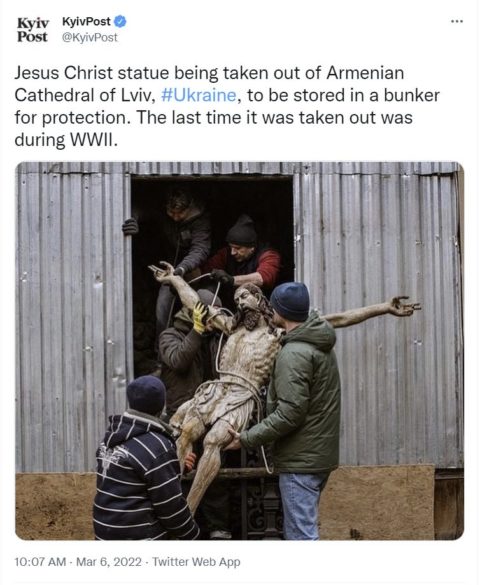
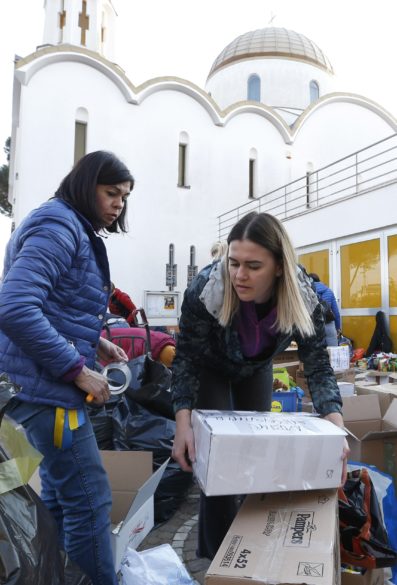
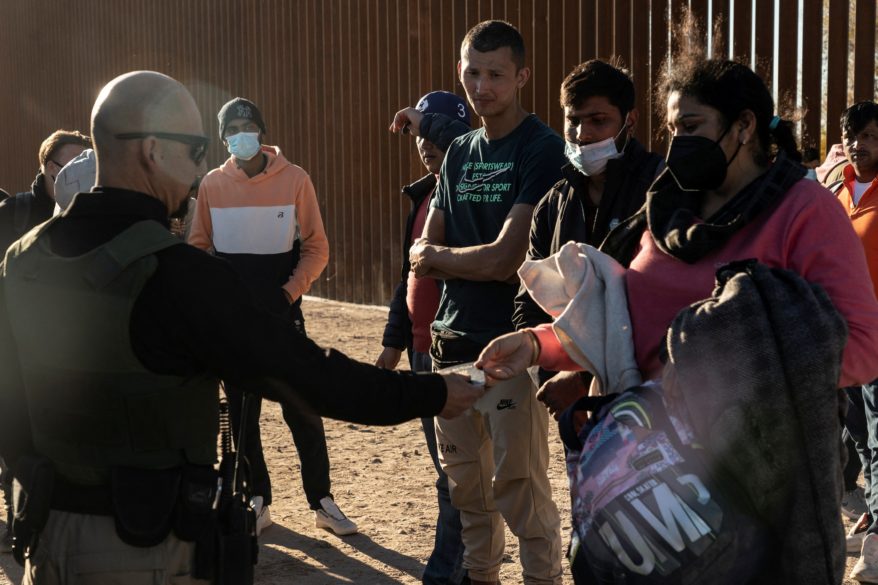
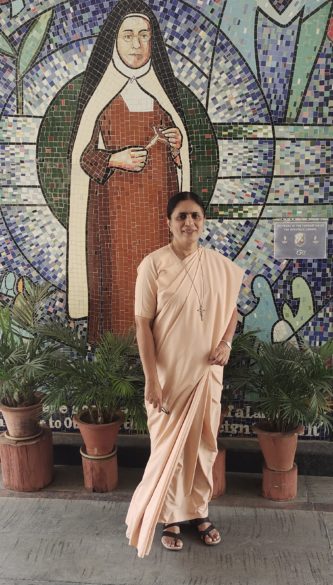
By Catholic News Service
LOUISVILLE, Ky. (CNS) – Archbishop Shelton J. Fabre, the newly appointed archbishop of the Archdiocese of Louisville, celebrated a Mass at Holy Family Church Feb. 8, saying to the congregation that his prayer for the archdiocese – his new home – is that “we will grow in our love for God and grow in our love for each other. To do so is a response to God who is laboring in every moment to love us first,” said Archbishop Fabre.
During the liturgy, Archbishop Joseph E. Kurtz – who has led the archdiocese since 2007 – welcomed Archbishop Fabre, calling the news of his appointment “joyous.”
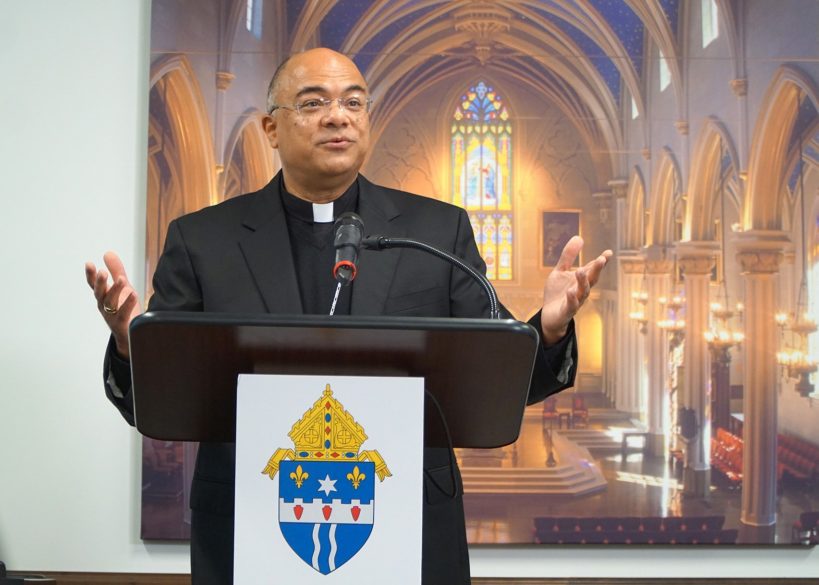
Archbishop Kurtz said he has known Archbishop Fabre for many years. “He’s a good friend of mine and he will be a good friend of yours,” said Archbishop Kurtz.
During the homily, Archbishop Fabre shared that between leaving his Louisiana home and coming to Louisville, his heart is divided.
“It delights me to be here today to greet this new home that is mine. It’s my honor and privilege to serve you, the good people of the Archdiocese of Louisville,” he said.
“I welcome this opportunity to meet you and yet my heart is divided for my family in Thibodaux who is learning today of the news that I am not with them. So my heart is divided today and I acknowledge that.”
Archbishop Fabre is not only leaving the members of the clergy, religious and faithful in the Diocese of Houma-Thibodaux, Louisiana, which he has led since 2013, he’s also leaving his siblings, he said.
Following the Mass, Archbishop Fabre held a news conference at the Archdiocese of Louisville Pastoral Center, where he spoke to members of the media and answered questions.
He will be installed as the fifth archbishop of Louisville March 30 at the Kentucky International Convention Center in downtown Louisville.
By Catholic News Service
WASHINGTON (CNS) – Pope Francis has accepted the resignation of Archbishop Joseph E. Kurtz of Louisville, Kentucky, and appointed as his successor Bishop Shelton J. Fabre of Houma-Thibodaux in southeastern Louisiana.
Archbishop Fabre, 58, is one of 12 of the U.S. Catholic Church’s African American prelates and he will be the first Black archbishop of Louisville. The newly named archbishop has headed the Louisiana diocese since 2013. He previously served as an auxiliary bishop of the Archdiocese of New Orleans from 2006 to 2013. He is chairman of the U.S. bishops’ Ad Hoc Committee Against Racism.
Archbishop Kurtz turned 75 Aug. 18, 2021, and as required by canon law, he turned in his resignation to the pope when he reached 75. He has headed the Louisville Archdiocese since August 2007.
The changes were announced Feb. 8 in Washington by Archbishop Christophe Pierre, apostolic nuncio.
Archbishop Fabre’s episcopal motto is “Comfort My People,” which he chose when he was ordained a bishop in 2007 as an auxiliary of New Orleans. He helped with rebuilding efforts that followed the devastation of Hurricane Katrina in 2005.
Eight years later, he was appointed the bishop of Houma-Thibodaux. In August 2021, his diocese and other parts of southern Louisiana suffered devastation wrought by Hurricane Ida.
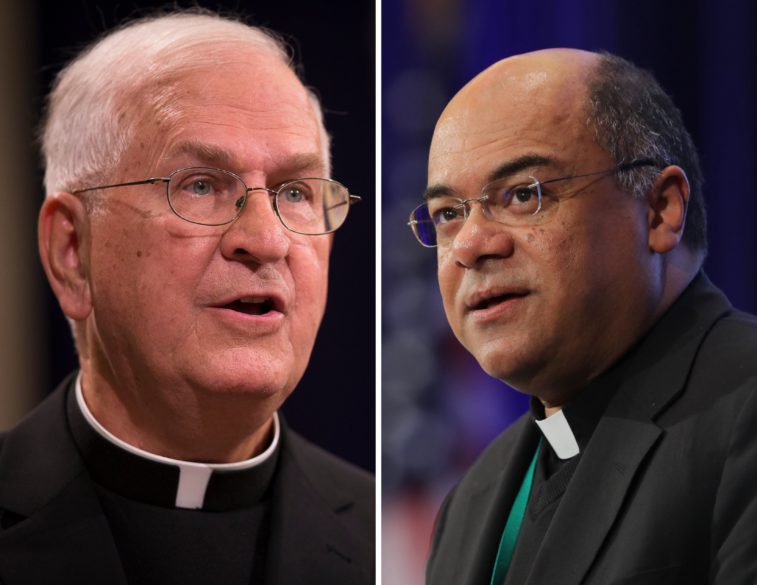
Regarding his motto, he said in a Feb. 8 statement that the words “are dear to my heart because they capture what I have always desired to do as a bishop, as a pastor of souls. I sincerely believe our Lord is communicating these words to his people right now.”
Shelton Joseph Fabre was born Oct. 25, 1963, in New Roads, Louisiana, the fifth of six children. He graduated in 1981 as valedictorian of Catholic High School of Pointe Coupée, Louisiana. He entered St. Joseph Seminary College in St. Benedict, Louisiana, graduating with a bachelor’s degree in history in 1985.
He continued his studies in Belgium at the American College in Louvain, a seminary that was affiliated with the Catholic University of Leuven, Belgium. He earned a bachelor of religious studies degree in 1987 and a master of religious studies degree in 1989 from the Catholic university.
He was ordained a priest for the Diocese of Baton Rouge, Louisiana, Aug. 5, 1989, and went on to serve as a pastor and associate pastor. He also served as a chaplain at Louisiana State Penitentiary at Angola, defender of the bond for the diocese’s marriage tribunal and dean of the diocese’s Northwest Deanery.
He also served on the diocesan priests’ council, college of consultors, school board and clergy personnel board. He was chairman of pastoral planning and director of the Office of Black Catholics.
As chairman of the bishops’ Ad Hoc Committee Against Racism, Archbishop Fabre led the writing of “Open Wide Our Hearts – The Enduring Call to Love,” approved by the body of bishops in 2018.
In March 2021, Archbishop Fabre discussed the pastoral with about 150 people in the Archdiocese of Louisville when he led an Archdiocesan Leadership Institute on the subject.
During the event, conducted online due to the pandemic, he centered his talk on “witnessing to the dignity of the human person as an antidote to the grave sin of racism.”
The following month, he and Archbishop Paul S. Coakley of Oklahoma City, chairman of the U.S. Conference of Catholic Bishops’ Committee on Domestic Justice and Human Development in a joint statement urging Catholics to “join in the hard work of peacefully rebuilding what hatred and frustration has torn down.”
“This is the true call of a disciple and the real work of restorative justice,” Bishop Fabre and Archbishop Coakley said. “Let us not lose the opportunity to pray that the Holy Spirit falls like a flood on our land again, as at Pentecost, providing us with spiritual, emotional and physical healing, as well as new ways to teach, preach, and model the Gospel message in how we treat each other.”
The two chairmen’s statement followed the jury’s April 20, 2021, verdict finding former Minneapolis police officer Derek Chauvin guilty in the death of George Floyd.
Archbishop Fabre is a former chairman of the USCCB’s Subcommittee on African-American Affairs and currently serves on the board of Catholic Relief Services, the U.S. bishops’ overseas relief and development agency.
As the archbishop of Louisville, he will shepherd about 156,000 Catholics in 24 counties of central Kentucky, from the Ohio River to the Tennessee border. The archdiocese, which dates to 1808, has 110 parishes that cover 8,124 miles. About 20,000 students are served by 48 schools from kindergarten to high school.
(Contributing to this story was Marnie McAllister, editor of The Record, newspaper of the Archdiocese of Louisville.)
By Carol Zimmermann
WASHINGTON (CNS) – Lent, the spiritual season of prayer and sacrifice, has an extra pull to it this year because once again – and now for the third time – it will be under the cloud of the coronavirus pandemic.
And even though the third Lent in a pandemic can feel like a lot like a Jesus’ third fall on the road to Calvary, people who spoke with Catholic News Service focused more on the season’s path to Easter and how this year’s Lent also coincides with an optimism around COVID-19 cases dropping in the U.S.
“It’s a perfect storm: lower (coronavirus) numbers just as Lent approaches,” said Mary DeTurris Poust, former communications director for the Diocese of Albany, New York.
Poust, who teaches yoga, leads retreats and writes a blog called “Not Strictly Spiritual,” said that during recent virtual retreats she has led, it’s obvious how much people want to reconnect in person.
And maybe this Lent, which starts on Ash Wednesday, March 2, is the time to do just that, she said about being with the parish community: gathering for Mass, prayer services and also for the returning soup suppers and fish fries.
After the tremendous losses of the past two years, she said, this Lent could be a good time for a reset. “Lent is the perfect opportunity to recalculate the internal GPS” of where we’re going, Poust said, speaking about individuals but also more broadly about what parishes can do as they look to welcome people back.
So many Catholics like the ritual of Lent and all of its “bells and smells,” she said, which makes this season a great opportunity “to pull them back in the best way.”

Jen Sawyer, editor-in-chief of Busted Halo, a Paulist website and satellite radio program, said in times of uncertainty, people “rely on muscle memory” of traditional faith practices they are used to. But this year, she thinks Lent’s usual traditions might have a different feel.
“It seems like this is the Lent we’re most prepared for; we’ve all sacrificed so much” she said. The desert experience of Lent has already been lived out and with so many people exhausted from the past two years, she said this Lent offers new opportunities to find peace, community and faith.
Paulist Father Larry Rice, campus chaplain for Rensselaer Polytechnic Institute in Troy, New York, agreed, saying the church is more than ready for Lent 2022 and he hopes it will help people “respond to all the trauma we have been through.”
“We are living with long-term, low-grade trauma,” he said, adding that for many, the pain is just under the surface and he sees Lent as the antidote. “As Christian people, we believe our destination is not Good Friday. We go through that to get to Easter,” he said.
He also said this year has the added hope that “by the time we get to Easter, the pandemic we’re experiencing will look different.” And with wisdom acquired in the past two years, he also added: “There are no guarantees; there could be new (coronavirus) variants.”
The past two Lents did not have that same thread of hope.
Lent 2020 started off without a hitch with just a small number of COVID-19 cases in the country but by the second week of Lent, in early March, some dioceses urged parishes to curtail handshaking at the sign of peace and Communion from the chalice. By the third week of Lent, many dioceses lifted Sunday Mass obligations and stopped public Masses and Lenten services such as Stations of the Cross, prayer services and fish fries.
Last year during Lent, more churches were open – although many were limiting congregation sizes and requiring parishioners to sign up for Masses. Fish fries were back, as carry-out events, and in many dioceses, ashes were sprinkled over heads on Ash Wednesday.
This year, parishes are open – with differing mask regulations and social distancing in place – and the beloved fish fries are back with both in-person or carry-out options.
“These past two years for all of us have not been easy, but God has been with us,” said Mercy Sister Carolyn McWatters, a liturgist and chair of the Prayer and Ritual Committee for the Sisters of Mercy.
Sister McWatters, who lives at the Sacred Heart Convent in Belmont, North Carolina, and is involved in ministry there with the order’s retired sisters, emphasized the need to reflect on the pandemic experience this Lent. She said it’s important to recognize how we lived beyond what we could control, the inner resources we relied on and where we saw goodness and grace at work.
“The cross is never a dead end. It points to new life. Where are the signs of life for me, my community, the country, the world?” she asked.
Spiritual growth is often about relinquishing control, she said, which was certainly an aspect to pandemic life but the coronavirus also involved the hardship of isolation which was especially experienced by the retired sisters.
The convent, part of a national center for the Mercy sisters, had been a frequent spot for meetings and gatherings and many came for Sunday Masses and dinners, which was all put on hold for the past two years.
“Everybody is looking for the end,” she said.
The view of these retired Mercy sisters echoes what many are feeling, but Sister McWatters also cautions against people focusing on being victims right now and seeing the pandemic purely as “woe is me.”
Similarly, she said, Lent is not gloom and doom but should be a “joyful embrace of what will help me to grow more deeply.”
Sawyer also stressed that faith is meant to be joyful and said that Busted Halo with its “Fast Pray Give Lent Calendar” and InstaLent photo challenge aims to get that across and will continue that this Lent particularly by urging people to try something new – a new book or prayer – and to check in with others after so much pandemic isolation.
“We don’t often think of Lent as a vibrant time of community connection,” she said, adding that Catholics are “used to the desert” experience often associated with the season. But this Lent, that might change.
By Samantha Smith
ATLANTA (CNS) – Under the bright lights and falling confetti, surrounded by his team, their families and thousands of fans in SoFi Stadium in Los Angeles, Sean McVay raised high the Vince Lombardi Super Bowl championship trophy Feb. 13.
To win the game feels outstanding, said McVay, head coach of the Los Angeles Rams. The Rams were behind in the third quarter and most of the fourth quarter, before scoring the winning touchdown with 1:25 left in Super Bowl LVI against the Cincinnati Bengals. The Rams won 23-20.
McVay called it “poetic.”
“You talk about a resilient team, coaches, players; I’m so proud of this group,” said McVay in postgame comments. “We talk about competitive greatness all the time, being your best when your best is required.”
McVay, 36, the youngest head coach to win a Super Bowl championship in NFL history, is a graduate of Marist School in Atlanta. He gives the Catholic school a lot of credit for instilling in him many “foundational principles” he said have been instrumental in his achievements.
Marist is an independent Catholic college preparatory school owned and operated by the Society of Mary. It is the oldest Catholic secondary school in the Atlanta area.
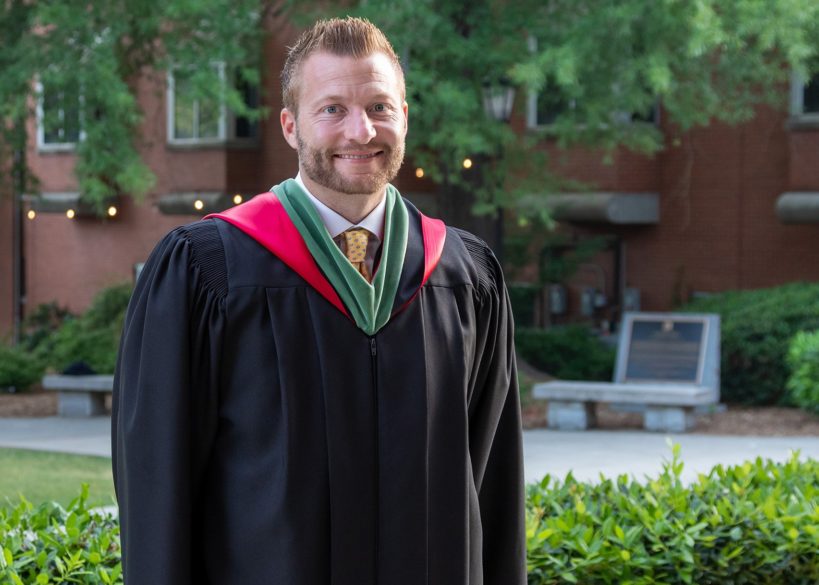
During his five seasons with the Rams, McVay has led the team to five consecutive winning seasons, two Super Bowl appearances and now a Super Bowl championship.
As his coaching career continues to soar, he continues to hold fond memories of his time at Marist School.
“Marist is a special place because of all the unique people,” McVay said to the 2021 Marist graduating class at their guest speaker. “I’ve been so fortunate and blessed because there’s so many of the foundational principles that were instilled in me from the time I got here, from seventh grade to 12th grade, that have been instrumental in a lot of the things that have been good in my life.”
The school honored McVay with the Distinguished Alumni Award in 2020.
McVay gravitated to football from soccer in eighth grade at Marist, following the footsteps of three McVay generations.
His father, Tim, played football at Indiana University in Bloomington. His grandfather, John, was vice president and director of football operations for the San Francisco 49ers from 1979 to 1995 and was inducted into the team’s Hall of Fame in 2013.
Alan Chadwick, head football coach at Marist for more than 40 years, described McVay as explosive, agile and competitive as a Marist player.
“He brought great intensity to his preparation, workouts and had tremendous understanding of the game,” said Chadwick.
McVay was a four-year starter and quarterback his junior and senior year while playing for the Marist War Eagles. In 2003, he led the football team to a state championship and was named the Georgia AAAA Offensive Player of the Year. McVay was the first player in the school’s history to rush and throw for 1,000 yards in consecutive seasons.
Atlanta Auxiliary Bishop Joel M. Konzen, who was principal of Marist School while McVay attended, remembers him as an easygoing and friendly student.
In 2003, when Marist won the state championship, Bishop Konzen recalls McVay’s leadership.
“The team acknowledged that he was their leader,” the bishop told The Georgia Bulletin, newspaper of the Atlanta Archdiocese. “Sean gave most of the credit to his teammates for a win, making light of his own contribution. That kind of modesty was how Sean demonstrated his commitment to the Marist Way.”
After graduating from Marist in 2004, McVay attended Miami University where he played wide receiver. In 2007, he received Miami’s Scholar Athlete Award and graduated with a bachelor of science degree in health and sports studies in 2008.
His NFL career began as assistant wide receivers coach for the Tampa Bay Buccaneers. After working for one year as the quality control and wide receivers coach for the Florida Tuskers of the United Football League, McVay returned to the NFL as assistant tight end coach for the Washington Redskins in 2010.
While coaching for Washington, it was apparent that McVay was going to be a good coach, said Chadwick.
McVay was promoted twice, eventually becoming Washington’s offensive coordinator. In 2016, he coached the offensive unit to record breaking statistics for the franchise.
McVay was named head coach for the Los Angeles Rams in 2017. At 30, he was the youngest NFL head coach in history. The Associated Press named McVay the Coach of the Year in 2018 – the youngest head coach to ever receive the award.
Three years ago, McVay made his first Super Bowl appearance as head coach for the Rams against the New England Patriots when the game was hosted in Atlanta.
Chadwick and McVay have kept in touch over the years. After the Rams won the NFC championship game against the 49ers Jan. 30, Chadwick reached out to his former player to wish him luck in the Super Bowl.
“He’s done extremely well for himself and should continue to do that for many years to come,” said Chadwick.
(Smith is a staff writer at The Georgia Bulletin, newspaper of the Archdiocese of Atlanta.)
NATION
CINCINNATI (CNS) – The Los Angeles Rams may have won Super Bowl LVI over the Cincinnati Bengals, but students in Catholic schools in both archdioceses are winners as well. Donors contributed more than $22,000 – and counting as of Feb. 17 – for tuition assistance scholarships as part of a friendly wager between Archbishop José H. Gomez of Los Angeles and Archbishop Dennis M. Schnurr of Cincinnati over the game’s outcome. The donations to each archdiocese’s Catholic Education Foundation came as the archbishops invited supporters to become involved in their good-gesture wager through the Bishops Big Game challenge. In the Feb. 13 game, the Rams were behind in the third quarter and most of the fourth quarter, before scoring the winning touchdown with 1:25 left, beating the Bengals 23-20. With the Rams’ victory, the Los Angeles foundation will receive 60% of the funds raised, while the Cincinnati foundation will received 40% of the money donated.
NASHVILLE, Tenn. (CNS) – From partaking in the sacrament of reconciliation to fasting to choosing what to give up, Lent is full of traditions that Catholics around the world take part in as they prepare to celebrate Christ’s passion, death and resurrection. But there’s another sacred tradition that dates back to the early days of the Crusades; one that allows them to “walk” the Via Dolorosa with Christ: the Stations of the Cross. The Stations of the Cross are a mini-pilgrimage, taking believers through the steps taken by Jesus on Good Friday, from his condemnation to his burial. The stations are a “way of prayerfully uniting oneself to the sacrifice of the Lord and his love for us,” said Father Eric Fowlkes, pastor of the Cathedral of the Incarnation in Nashville. “It’s also an invitation for us to place ourselves within that journey.” The Stations of the Cross date back to the Middle Ages during the religious wars between Christians and Muslims, known as the Crusades. “The Crusades awakened an interest in Europe in the places associated with Christ in the Holy Land. For the first time, Europeans were traveling there regularly and wanted to see the holy places where the biblical events took place,” said Father Bede Price, pastor of Church of the Assumption in Nashville.

VATICAN
VATICAN CITY (CNS) – Pope Francis advanced the sainthood cause of Argentine Cardinal Eduardo Pironio, the prelate who organized and oversaw the first six international celebrations of World Youth Day. The pope also approved a decree recognizing a miracle attributed to the intercession of Capuchin Poor Clare Sister Maria Costanza Panas of the Italian monastery of Fabriano. She was born Jan. 5, 1896, and died May 28, 1963. In addition to recognizing the miracle that clears the way for her beatification, the pope approved decrees recognizing that four candidates for sainthood heroically lived the Christian virtues; the decrees were signed during an audience Feb. 18 with Cardinal Marcello Semeraro, prefect of the Congregation for Saints’ Causes. The four candidates, who are now “venerable,” included Cardinal Pironio, who had served in numerous offices in the Roman Curia from 1975 until his retirement in 1996. St. Paul VI called him to Rome as pro-prefect of the Vatican congregation for religious. When St. John Paul II named him to head the Pontifical Council for the Laity in 1984, the late pope instituted the annual celebration of World Youth Day, including huge international gatherings presided over by the pope every two years and organized by the laity council.
VATICAN CITY (CNS) – As part of ongoing measures to reform the Roman Curia, Pope Francis has approved restructuring the Congregation for the Doctrine of the Faith, the oldest of the congregations. Once comprised of a doctrinal office, a discipline office and a marriage office, the new structure will see the doctrinal and discipline offices become their own special sections led by their own secretaries; the marriage office will become part of the doctrinal office. The two secretaries will serve under the congregation’s prefect. Spanish Cardinal Luis Ladaria, who has been prefect of the congregation since 2017, will celebrate his 78th birthday April 19. The heads of Vatican offices are required to offer their resignations to the pope when they turn 75. In “Fidem servare” (Preserving the Faith), published “motu proprio,” (on his own initiative) Feb. 14, Pope Francis said the main task of the congregation has been to safeguard or “keep the faith.” The changes went into effect the same day. Over time, the congregation has seen modifications to its areas of responsibilities and how it is configured, and now, Pope Francis said, further change is needed “to give it an approach more suited to the fulfillment of its functions.”
WORLD
SÃO PAULO (CNS) – The Diocese of Petrópolis and the city’s parishes have opened their doors to assist victims of the torrential rainstorm that flooded the historic city of Petrópolis. Bishop Gregório Paixão Neto asked that priests and parishioners take in people whose houses were affected by the Feb. 15 mudslides and needed shelter. “This moment is one of solidarity, and we of the Catholic Church are deeply united and in solidarity with all families,” Bishop Paixão said in a video message released on social media. “I ask you to welcome your relatives, your friends and those who are in despair, looking for a place to stay. I, myself, already have a family staying in my house,” he added. The mid-February storm is considered one of the worst in city in the past 70 years, with rainfall surpassing 10 inches in six hours, a volume greater than expected for the entire month of February. As of early Feb. 17, 104 deaths had been recorded, and dozens were still missing under the mud and rubble. The Archdiocese of Rio de Janeiro, through Caritas, launched the SOS Petrópolis campaign, asking for donations for families affected by the rains.
IQUITOS, Peru (CNS) – Oil spills on opposite sides of Peru – one near Lima, the coastal capital, and the other in a remote Indigenous village in the Amazon – brought together Catholics in the two regions for simultaneous Masses Feb. 13. They prayed for those suffering from the pollution caused by both spills as they marked the second anniversary of “Querida Amazonia,” (Beloved Amazonia), the papal exhortation issued by Pope Francis after the 2019 Synod of Bishops for the Amazon. The liturgies, accompanied by video messages exchanged by Bishop Miguel Angel Cadenas of Iquitos and Archbishop Carlos Castillo Mattasoglio of Lima and played at each of the Masses, formed the first such joint initiative between bishops in Lima and the Amazon. In January, similar disasters struck the two regions. A ship offloading oil Jan. 15 at a coastal refinery spilled about 6,000 barrels of oil into the Pacific Ocean, fouling at least 30 miles of shoreline. On Jan. 20, vandals cut an oil pipeline in a small Amazonian village, contaminating the river that people depend on for water for drinking, cooking and bathing. In his homily, Archbishop Castillo said, “We have a commitment – our city of Lima and our entire coast – to our Amazon region.”
Por Rhina Guidos
WASHINGTON (CNS) – Republicanos están divididos sobre un proyecto de ley de inmigración presentado por miembros de su propio partido que otorgaría la ciudadanía a millones de personas que se encuentran en el país sin permiso legal.
La congresista María Elvira Salazar, de Florida, en una conferencia de prensa el 9 de febreo, habló sobre la Ley de Dignidad, un proyecto de ley que ayudaría a aquellos que fueron traídos al país como menores sin permiso legal y otros que contribuyen a los EE. UU. mientras que también se enfocaría en reforzar la frontera.
“Estados Unidos ha sido históricamente un faro de refugio para quienes huyen de la violencia y la opresión o buscan una nueva vida y oportunidades”, dijo Salazar. “En las últimas décadas, se ha explotado nuestro fallido sistema de inmigración, lo que ha llevado a una situación que es impropia de nuestra gran nación”.
“Si bien Estados Unidos es una nación de leyes, también somos una nación de segundas oportunidades”, dijo. “A través de la dignidad y una oportunidad de redención, este legado puede continuar”.
Salazar presentó algunas de las disposiciones de la propuesta que incluyen que los inmigrantes paguen $1,000 anuales durante 10 años en un fondo como restitución y ese dinero ayudaría a capacitar a otros trabajadores.

La medida “agilizaría” el camino para los menores que ingresaron ilegalmente al país cuando eran niños y reforzaría las estructuras y los sistemas en la frontera de EE. UU. con México – también fundado por un impuesto que se le cobraría a los inmigrantes que solicitan legalizar su situación.
Pero “no tendrán acceso a los beneficios o derechos federales con verificación de recursos”, dijo un comunicado de prensa que describe el proyecto de ley.
Los miembros del propio partido de Salazar se opusieron, exponiendo las divisiones dentro del Partido Republicano entre los que quieren respaldar la reforma migratoria y los que se oponen por completo, calificándola de una especie de “amnistía”.
“Le he pedido a algunos de mis colegas que me expliquen y que me den una definición rigurosa de lo que significa (amnistía). Nadie me la ha podido dar”, dijo Salazar.
El republicano Ronald Reagan en 1986 fue el último presidente estadounidense que logró que el Congreso aprobara una legislación que legalizó, a gran escala, a grupos que habían ingresado al país sin permiso, otorgando a 3 millones de personas lo que algunos llaman “amnistía”.
El republicano de Texas Pete Sessions, así como los miembros republicanos Jenniffer González-Colón de Puerto Rico, Dan Newhouse del estado de Washington, John Curtis de Utah, Tom Reed de Nueva York y Peter Meijer de Michigan han mostrado su apoyo al proyecto de ley.
Sin embargo, otros, como el republicano de Carolina del Norte, Madison Cawthorn, dijeron que la propuesta es “peligrosa”.
Fox News Digital, en un artículo del 9 de febrero citó a Cawthorn diciendo que cualquier propuesta debería “centrarse en las deportaciones y asegurar nuestra frontera”.
Los demócratas también han hecho repetidos intentos de reforma migratoria, pero ninguno de los proyectos de ley que han presentado ha podido obtener el apoyo de una mayoría en el Congreso.